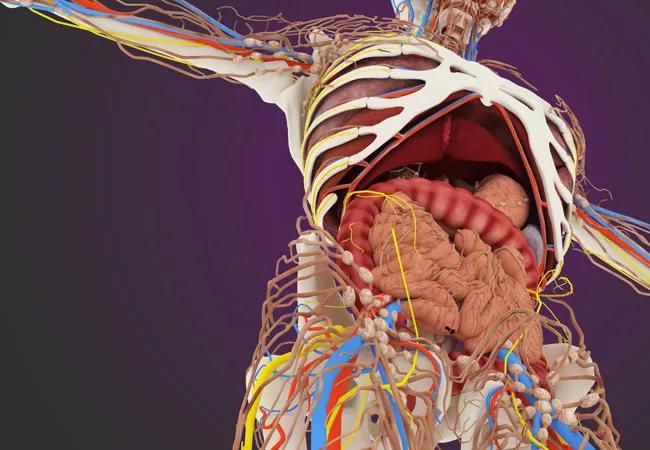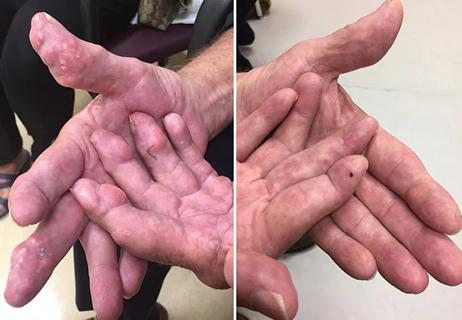New developments in an uncommon disease

Advertisement
Cleveland Clinic is a non-profit academic medical center. Advertising on our site helps support our mission. We do not endorse non-Cleveland Clinic products or services. Policy
A 40-year-old male presents to the emergency department with a severe headache. On arrival his blood pressure is 220/120. He describes a two-week history of feeling ill with loss of appetite, intermittent right flank pain, and areas of numbness over his bilateral lower extremities. On exam he is tachycardic and appears unwell. In addition to the hypertension, his examination is notable for decreased sensation along his anterior lower extremities and weakness in right foot dorsiflexion. Computed tomography (CT) of the abdomen is performed that reveals bilateral wedge-shaped infarcts in the renal parenchyma. A CT angiogram (CTA) is normal. You are contacted with the question as to whether the normal CTA has ruled out polyarteritis nodosa.
Polyarteritis nodosa (PAN) is a disease with a historical past and intriguing future. Although Virchow and Rokitansky described pathologic arterial changes later recognized to be due to vasculitis, the detailed clinical and histopathologic report of periarteritis nodosa by Kussmaul and Meier in 1866 is generally recognized as the seminal published report that introduced this unique and life-threatening disease entity1. In the early 1900s, the name was modified to polyarteritis nodosa in recognition that inflammation was not confined to the adventitia and occurred throughout the vessel.
Since that time, the concept of PAN has continued to evolve as our understanding of this disease has grown. Following the description of PAN, most instances of vasculitis were referred to using this terminology. During 1920-1940, individual forms of vasculitis affecting the small- to medium-sized vessels began to be described. Pearl Zeek in 1952 presented the first classification system which separated other forms of vasculitis from PAN.2 The most significant nomenclature changes impacting PAN occurred with the Chapel Hill Consensus Conference (CHCC) definitions published in 1994 in which PAN was differentiated from microscopic polyangiitis (MPA).3 Although a microscopic variant of PAN associated with glomerulonephritis and pulmonary capillaritis had been recognized since the 1940s, the CHCC formally identified MPA as being a unique disease entity separate from PAN. The most recent CHCC vasculitis nomenclature published in 2013 defines PAN as being a “necrotizing arteritis of medium or small arteries without glomerulonephritis or vasculitis involving arteries, capillaries or venules and not associated with antineutrophil cytoplasmic antibodies (ANCA).”4
Advertisement
As currently defined, PAN is an uncommon entity but remains potentially life-threatening with features that can affect the peripheral and central nervous system, heart, gastrointestinal tract and renal vessels. Renal involvement can manifest as hypertension, renal infarcts, perinephric hematuria and renal insufficiency. The diagnosis of PAN is established by the constellation of clinical features usually in combination with consistent histologic or arteriographic findings. Because PAN affects the medium-sized vessels, visualization typically requires catheter-directed dye arteriography as vessels of this size cannot currently be visualized by CTA or magnetic resonance arteriography (MRA). In applying this to our case patient, the normal CTA does not rule out PAN and this should be further pursued with a catheter-directed dye arteriogram given the patients suggestive clinical features.
Treatment of PAN is based on the degree of disease severity with organ- or life-threatening disease usually being treated with glucocorticoids and cyclophosphamide.
The most recent intriguing development in the PAN story has been the recognition of a PAN-like vasculitis being described in conjunction with deficiency of adenosine deaminase type 2 (DADA2).5 Patients with DADA2 usually present in childhood with a variable pattern of clinical involvement that includes ischemic and hemorrhagic strokes, skin findings, portal and systemic hypertension, hematologic abnormalities, immune deficiency and vascular pathology. At a plenary session of the 2018 American College of Rheumatology annual meeting, results were presented of a study in which 117 patients with idiopathic PAN were screened for mutations in ADA2. Of these 117 patients, eight were identified as having a missense variant in ADA2, suggesting that DADA2 accounts for a subset of patients with idiopathic PAN.6 This is important as TNF inhibitors have potential efficacy in DADA2, which would not be the usual treatment for PAN. These findings suggest that DADA2 should be considered in patients with idiopathic PAN, especially in those who present with early onset disease.
Advertisement
PAN remains a complex disease whose story has continued to evolve over time. The rich history of PAN serves as a reminder that every disease provides opportunities for novel insights that may beneficially impact patient management and outcome.
About the author: Dr. Langford is Director of the Center for Vasculitis Research at Cleveland Clinic as well as Vice Chair for Research, Department of Rheumatic and Immunologic Diseases.
Advertisement
Advertisement

Genetic testing at Cleveland Clinic provided patient with an updated diagnosis

From dryness to diagnosis

Older Psoriasis Patients May Experience Quicker Transition

Cleveland Clinic’s Rheumatic Lung Disease program treats patients with complex conditions

Some patients exhibit marked nodulosis due to undiagnosed tophi

A century-old medical tradition inspired the weekly complex-case reviews in Rheumatology

Multidisciplinary care may help clear barriers to treatment

Genetic polymorphisms and response to TNFα blockers